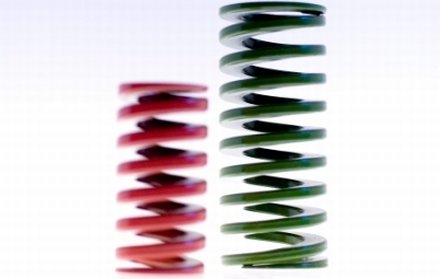Die springs
Contents |
Introduction
Die springs play an integral role within the manufacturing and engineering industries. Similar to compression springs, die springs are manufactured and built to take a higher load than other springs, making them a valuable tool for a variety of projects.
For a die spring to work without hindrance, there has to be room for it to work. This means the starting point is not the physical dimensions of the die spring, but the installation dimensions.
What are die springs?
Also referred to as ‘high compression springs’, die springs are designed to maintain and withstand great levels of applied stress. These types of springs are made with rectangular wire instead of circular, unlike their ‘compression’ counterparts.
This type of high force compression spring can handle 30% more stress than a standard compression spring. This can be beneficial in extreme and stressful environments, such as handling temperatures rising to 475 degrees.
Properties of die springs
Die springs have a number of unique qualities, the first being the material they are made from. The use of rectangular and square wire is the prime element that gives the die spring its unique property, and it is this larger mass which provides the spring with a greater force.
Die springs are an extremely reliable and consistent spring. They can be manufactured to different strengths, which is shown through the use of different colour codes.
Common uses of die springs
Due to their strength, die springs are used for a wide range of applications within various industries, including:
- Clutches and brakes in the automotive industry.
- Transportation industry.
- Agricultural industry.
The difference between compression and die springs
Springs may look similar, but the different variations of springs all have different characteristics, designed for different purposes. Compression and die springs are two which are similar, but with several differences.
Compression springs function by resisting compressive force. When stress and pressure is applied, their length shortens, allowing them to store energy whilst compressed.
Compression springs are used in a wide range of applications, including:
- Ballpoint pens
- Door locks
- Automotive systems
- Medical devices
- Electrical devices
- Mattresses
Die springs differ due to their high force. Die springs are engineered to provide predetermined pressure, meaning they are suited to applications involving extreme conditions, high temperature, high loads or heavy machinery, making them an ideal choice for applications which require high force within a limited area.
They can be engineered to consistently give predetermined physical force at certain compressions, ideal components, for example, in punching and pressing machines.
Related articles on Designing Buildings Wiki
- Compression springs.
- E-spring.
- Flat springs.
- Key qualities of springs.
- Spring materials.
- The importance of gas springs.
- Tension springs v torsion springs.
- Using springs in construction to prevent disaster.
- Large and Hot Coiled Compression Springs
- The Difference Between Tension and Torsion Springs
- The Multiple Uses of Compression Springs
- The Uses of Wire Forms Within the Construction Industry
- Types of spring.
Featured articles and news
Infrastructure that connect the physical and digital domains.
Harnessing robotics and AI in challenging environments
The key to nuclear decommissioning and fusion engineering.
BSRIA announces Lisa Ashworth as new CEO
Tasked with furthering BSRIA’s impressive growth ambitions.
Public buildings get half a million energy efficiency boost
£557 million to switch to cleaner heating and save on energy.
CIOB launches pre-election manifesto
Outlining potential future policies for the next government.
Grenfell Tower Inquiry announcement
Phase 2 hearings come to a close and the final report due in September.
Progress from Parts L, F and O: A whitepaper, one year on.
A replicated study to understand the opinion of practitioners.
ECA announces new president 2024
Electrical engineer and business leader Stuart Smith.
A distinct type of countryside that should be celebrated.
Should Part O be extended to existing buildings?
EAC brands heatwave adaptation a missed opportunity.
Definition of Statutory in workplace and facilities management
Established by IWFM, BESA, CIBSE and BSRIA.
Tackling the transition from traditional heating systems
59% lack the necessary information and confidence to switch.
The general election and the construction industry
As PM, Rishi Sunak announces July 4 date for an election.
Eco apprenticeships continue help grow green workforce
A year after being recognised at the King's coronation.
Permitted development rights for agricultural buildings
The changes coming into effect as of May 21, 2024.






















